Complex Continues Wavelets
Contents
Complex Continues Wavelets¶
Notebook¶
A quick example to compare different wavelets¶
import numpy as np
import matplotlib.pyplot as plt
import spkit
print('spkit-version ', spkit.__version__)
import spkit as sp
from spkit.cwt import ScalogramCWT
from spkit.cwt import compare_cwt_example
# if above two lines raise error, use sp.cwt.ScalogramCWT and sp.cwt.compare_cwt_example instead
x,fs = sp.load_data.eegSample_1ch()
t = np.arange(len(x))/fs
compare_cwt_example(x,t,fs=fs)
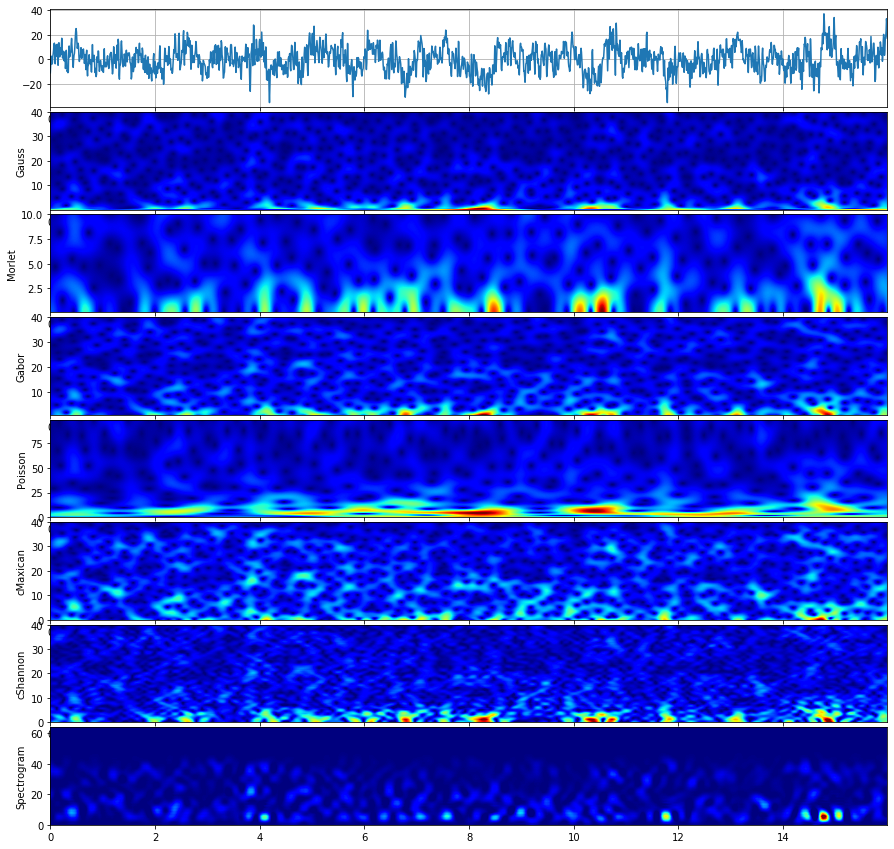

Gauss wavelet¶
The Gauss Wavelet function in time and frequency domain are defined as \(\psi(t)\) and \(\psi(f)\) as below;
where
Parameters for a Gauss wavelet:
f0 - center frequency
Q - associated with spread of bandwidth, as a = (f0/Q)^2
import numpy as np
import matplotlib.pyplot as plt
import spkit
print('spkit-version ', spkit.__version__)
import spkit as sp
from spkit.cwt import ScalogramCWT
Parameters for a Gauss wavelet:
f0 - center frequency
Q - associated with spread of bandwidth, as a = (f0/Q)^2
Plot wavelet functions¶
fs = 128 #sampling frequency
tx = np.linspace(-5,5,fs*10+1) #time
fx = np.linspace(-fs//2,fs//2,2*len(tx)) #frequency range
f01 = 2 #np.linspace(0.1,5,2)[:,None]
Q1 = 2.5 #np.linspace(0.1,5,10)[:,None]
wt1,wf1 = sp.cwt.GaussWave(tx,f=fx,f0=f01,Q=Q1)
f02 = 2 #np.linspace(0.1,5,2)[:,None]
Q2 = 0.5 #np.linspace(0.1,5,10)[:,None]
wt2,wf2 = sp.cwt.GaussWave(tx,f=fx,f0=f02,Q=Q2)
plt.figure(figsize=(15,4))
plt.subplot(121)
plt.plot(tx,wt1.T.real,label='real')
plt.plot(tx,wt1.T.imag,'--',label='image')
plt.xlim(tx[0],tx[-1])
plt.xlabel('time')
plt.ylabel('Q=2.5')
plt.legend()
plt.subplot(122)
plt.plot(fx,abs(wf1.T), alpha=0.9)
plt.xlim(fx[0],fx[-1])
plt.xlim(-5,5)
plt.xlabel('Frequency')
plt.show()
plt.figure(figsize=(15,4))
plt.subplot(121)
plt.plot(tx,wt2.T.real,label='real')
plt.plot(tx,wt2.T.imag,'--',label='image')
plt.xlim(tx[0],tx[-1])
plt.xlabel('time')
plt.ylabel('Q=0.5')
plt.legend()
plt.subplot(122)
plt.plot(fx,abs(wf2.T), alpha=0.9)
plt.xlim(fx[0],fx[-1])
plt.xlim(-5,5)
plt.xlabel('Frequency')
plt.show()


With a range of scale parameters¶
f0 = np.linspace(0.5,10,10)[:,None]
Q = np.linspace(1,5,10)[:,None]
#Q = 1
wt,wf = sp.cwt.GaussWave(tx,f=fx,f0=f0,Q=Q)
plt.figure(figsize=(15,4))
plt.subplot(121)
plt.plot(tx,wt.T.real, alpha=0.8)
plt.plot(tx,wt.T.imag,'--', alpha=0.6)
plt.xlim(tx[0],tx[-1])
plt.xlabel('time')
plt.subplot(122)
plt.plot(fx,abs(wf.T), alpha=0.6)
plt.xlim(fx[0],fx[-1])
plt.xlim(-20,20)
plt.xlabel('Frequency')
plt.show()

Signal Analysis - EEG¶
x,fs = sp.load_data.eegSample_1ch()
t = np.arange(len(x))/fs
print('shape ',x.shape, t.shape)
plt.figure(figsize=(15,3))
plt.plot(t,x)
plt.xlabel('time')
plt.ylabel('amplitude')
plt.xlim(t[0],t[-1])
plt.grid()
plt.show()

Scalogram with default parameters¶
## With default setting of f0 and Q # f0 = np.linspace(0.1,10,100) # Q = 0.5
XW,S = ScalogramCWT(x,t,fs=fs,wType='Gauss',PlotPSD=True)
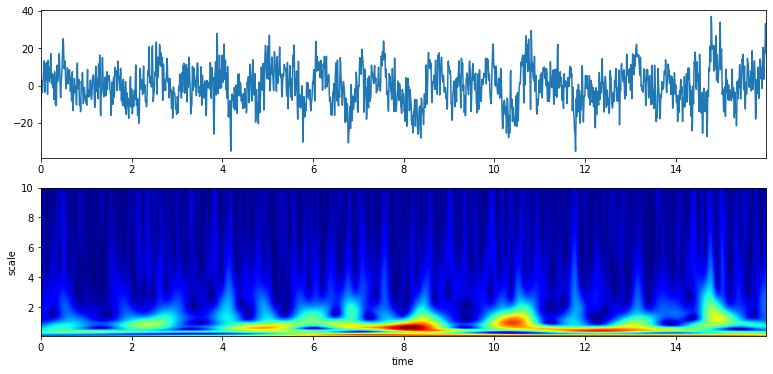
With a range of frequency and Q¶
# from 0.1 to 10 Hz of analysis range and 100 points
f0 = np.linspace(0.1,10,100)
Q = np.linspace(0.1,5,100)
XW,S = ScalogramCWT(x,t,fs=fs,wType='Gauss',PlotPSD=True,f0=f0,Q=Q)
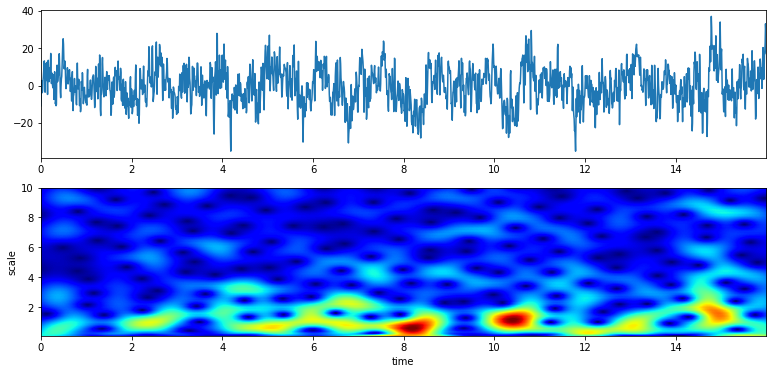
# from 5 to 10 Hz of analysis range and 100 points
f0 = np.linspace(5,10,100)
Q = np.linspace(1,4,100)
XW,S = ScalogramCWT(x,t,fs=fs,wType='Gauss',PlotPSD=True,f0=f0,Q=Q)
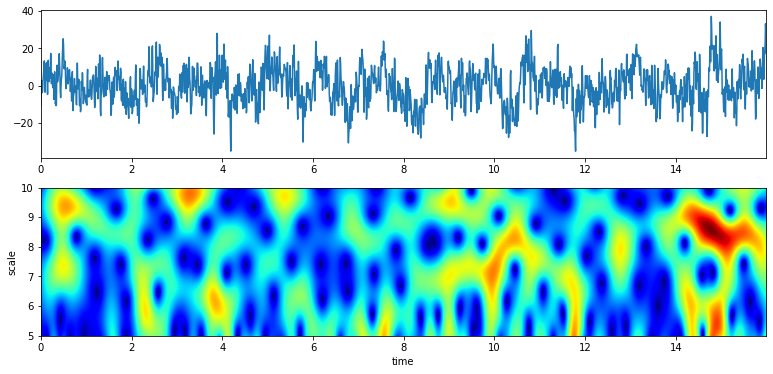
# With constant Q
f0 = np.linspace(5,10,100)
Q = 2
XW,S = ScalogramCWT(x,t,fs=fs,wType='Gauss',PlotPSD=True,f0=f0,Q=Q)
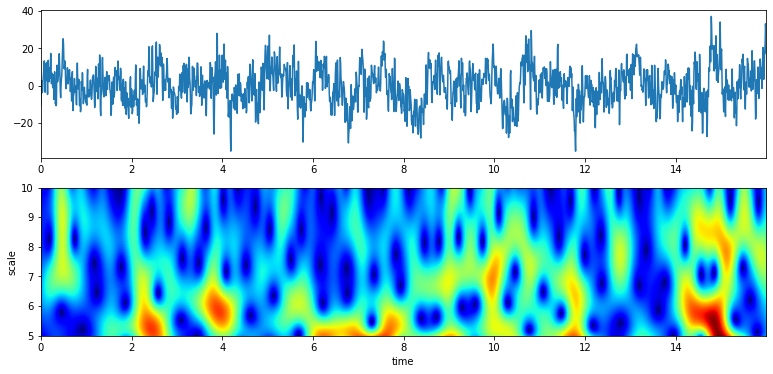
# From 12 to 24 Hz
f0 = np.linspace(12,24,100)
Q = 4
XW,S = ScalogramCWT(x,t,fs=fs,wType='Gauss',PlotPSD=True,f0=f0,Q=Q)
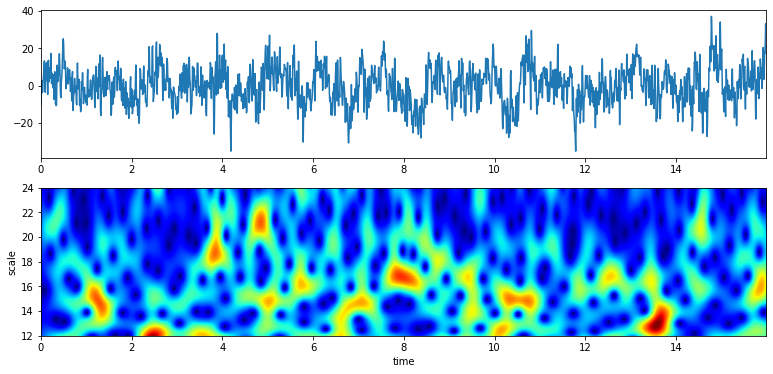
With a plot of analysis wavelets¶
f0 = np.linspace(12,24,100)
Q = 4
XW,S = ScalogramCWT(x,t,fs=fs,wType='Gauss',PlotPSD=True,PlotW=True, f0=f0,Q=Q)

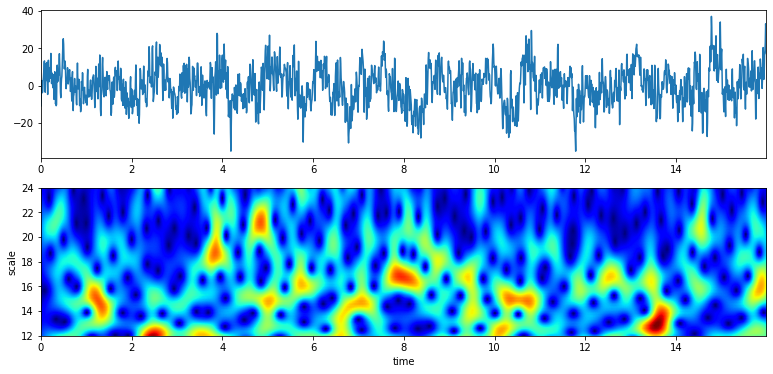
#TODO Speech/Audio Signal
Speech¶
#TODO
Audio¶
#TODO
Morlet wavelet¶
#TODO
The Morlet Wavelet function in time and frequency domain are defined as \(\psi(t)\) and \(\psi(f)\) as below;
where
XW,S = ScalogramCWT(x,t,fs=fs,wType='Morlet',PlotPSD=True)
Gabor wavelet¶
#TODO
The Gabor Wavelet function (technically same as Gaussian) in time and frequency domain are defined as \(\psi(t)\) and \(\psi(f)\) as below;
where \(a\) is oscilation rate and \(f_0\) is center frequency
XW,S = ScalogramCWT(x,t,fs=fs,wType='Gabor',PlotPSD=True)
Poisson wavelet¶
Poisson wavelet is defined by positive integers ($n$), unlike other, and associated with Poisson probability distribution
The Poisson Wavelet function in time and frequency domain are defined as \(\psi(t)\) and \(\psi(f)\) as below;
#Type 1 (n)¶
where
Admiddibility const \(C_{\psi} =\frac{1}{n}\) and \(w = 2\pi f\)
XW,S = ScalogramCWT(x,t,fs=fs,wType='Poisson',method = 1,PlotPSD=True)
#Type 2¶
where
XW,S = ScalogramCWT(x,t,fs=fs,,wType='Poisson',method = 2,PlotPSD=True)
#Type 3 (n)¶
where
XW,S = ScalogramCWT(x,t,fs=fs,wType='Poisson',method = 3,PlotPSD=True)
#TODO
Maxican wavelet¶
Complex Mexican hat wavelet is derived from the conventional Mexican hat wavelet. It is a low-oscillation wavelet which is modulated by a complex exponential function with frequency \(f_0\) Ref..
The Maxican Wavelet function in time and frequency domain are defined as \(\psi(t)\) and \(\psi(f)\) as below;
where \(w = 2\pi f\) and \(w_0 = 2\pi f_0\)
XW,S = ScalogramCWT(x,t,fs=fs,wType='cMaxican',PlotPSD=True)
#TODO
Shannon wavelet¶
Complex Shannon wavelet is the most simplified wavelet function, exploiting Sinc function by modulating with sinusoidal, which results in an ideal bandpass filter. Real Shannon wavelet is modulated by only a cos function Ref.
The Shannon Wavelet function in time and frequency domain are defined as \(\psi(t)\) and \(\psi(f)\) as below;
where
where \(\prod (x) = 1\) if \(x \leq 0.5\), 0 else and \(w = 2\pi f\) and \(w_0 = 2\pi f_0\)
XW,S = ScalogramCWT(x,t,fs=fs,wType='cShannon',PlotPSD=True)
#TODO
